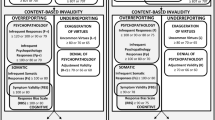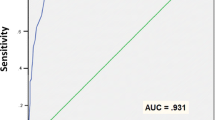Abstract
Individuals who are motivated to feign psychological problems to achieve a desired outcome (e.g., insanity defense) may overreport symptoms of psychopathology, with type of pathology being dependent on the setting. In the current investigation, we examined the utility of the overreporting validity scales (infrequent responses [F-r], infrequent psychopathology responses [FP-r], infrequent somatic responses [Fs], and symptom validity [FBS-r]) on the Minnesota Multiphasic Personality Inventory-2-Restructured Form (Ben-Porath and Tellegen 2008) to detect research participants instructed to simulate one of three mental disorders: major depressive disorder (MDD), schizophrenia (SCH), or post-traumatic stress disorder (PTSD). The restructured clinical (RC) and overreporting validity scale scores of bona fide psychiatric patients with a primary diagnosis of either MDD, SCH, or PTSD were compared to two groups of simulators—naïve (i.e., undergraduate students with no training in mental disorders) and sophisticated (i.e., individuals with advanced training in psychopathology or personal experience with the disorder asked to overreport symptoms). Examination of the RC Scale profiles revealed that the sophisticated simulators produced symptom profiles more similar to the profiles of the psychiatric patients than did the naïve simulators. For the overreporting validity scales, the sophisticated simulators were less likely to be detected as feigning compared to the naïve simulators; overall, the validity scales were able to distinguish patients from simulators and accurately classify most of the simulators regardless of their level of “symptom” sophistication. Examination and comparison of the validity scales revealed that across disorders and level of research participant symptom sophistication, the FP-r scale best differentiated simulators from patients.



Similar content being viewed by others
Notes
This data was previously used in studies which investigated the utility of the validity scales on the MMPI-2 in detecting overreporting of specific disorders and examined the effects of mental health training on the utility of these scales (Bagby et al. 1997a, 2000; Bury and Bagby 2002; Efendov et al. 2008). The current study extended these investigations to the MMPI-2-RF validity scales, as well as introduced a focus on the effect of individual experience with a disorder (PTSD) on the utility of these scales.
Full instructions can be found in the original articles or provided by the authors.
A subset of undergraduate students (n = 50) who overreported depression received course credit only, but were told that the four most convincing simulators would earn $50.
Subsequent to these original data collections, an additional 8 advanced clinical psychology graduate students overreporting symptoms of MDD on the MMPI-2-RF have been collected and added to this study.
We also conducted regression analyses using a backward stepwise entry method, in which all validity scales were entered in the first step, with non-significant predictors being removed until only significant predictors remained in the equation. These results did not indicate any differences in incremental validity compared to the hierarchical regression analyses.
References
American Psychiatric Association. (1994). Diagnostic and statistical manual of mental disorders (text revision) (4th ed.). Washington: American Psychiatric Association.
Arbisi, P. A., & Ben-Porath, Y. S. (1995). An MMPI-2 infrequent response scale for use with psychopathological populations: the F(p) scale. Psychological Assessment, 7, 424–431.
Bacchiochi, J. R., & Bagby, R. M. (2006). Development and validation of the Malingering Discriminant Function Index for the MMPI-2. Journal of Personality Assessment, 87, 51–61.
Bagby, R. M., Rogers, R., Buis, T., & Kalemba, V. (1994). Malingered and defensive response styles on the MMPI-2: an examination of validity scales. Assessment, 1, 31–38.
Bagby, R. M., Rogers, R., Buis, T., Nicholson, R. A., Rector, N. A., Schuller, D. R., et al. (1997a). Detecting feigned depression and schizophrenia on the MMPI-2. Journal of Personality Assessment, 68, 650–664.
Bagby, R. M., Rogers, R., Nicholson, R., Buis, T., Seeman, M. V., & Rector, N. (1997b). Does clinical training facilitate feigning schizophrenia on the MMPI-2? Psychological Assessment, 9, 106–112.
Bagby, R. M., Nicholson, R. A., Buis, T., & Bacchiochi, J. R. (2000). Can the MMPI-2 validity scales detect depression feigned by experts? Assessment, 7, 55–62.
Bagby, R. M., Marshall, M. B., & Bacchiochi, J. R. (2005). The validity and clinical utility of the MMPI-2 Malingering Depression scale. Journal of Personality Assessment, 85, 304–311.
Bagby, R., Marshall, M., Bury, A., Bacchiochi, J., & Miller, L. (2006). Assessing underreporting and overreporting response styles on the MMPI-2. In J. N. Butcher (Ed.), MMPI-2: a practitioner’s guide (pp. 39–69). Washington: American Psychological Association.
Ben-Porath, Y. S., & Tellegen, A. (2008). Minnesota Multiphasic Personality Inventory-2 Restructured Form; manual for administration, scoring, and interpretation. Minneapolis: University of Minnesota Press.
Bury, A. S., & Bagby, R. M. (2002). The detection of feigned uncoached and coached posttraumatic stress disorder with the MMPI-2 in a sample of workplace accident victims. Psychological Assessment, 14, 472–484.
Butcher, J. N., Graham, J. R., Ben-Porath, Y. S., Tellegen, A., Dahlstrom, W. G., & Kaemmer, B. (2001). Minnesota Multiphasic Personality Inventory-2: manual for administration and scoring (2nd ed.). Minneapolis: University of Minnesota Press.
Cohen, J. (1988). Statistical power analysis for the behavioral sciences (2nd ed.). Hillsdale: Erlbaum.
Efendov, A. A., Sellbom, M., & Bagby, R. M. (2008). The utility and comparative incremental validity of the MMPI-2 and trauma symptom inventory validity scales in the detection of feigned PTSD. Psychological Assessment, 20, 317–326.
Elhai, J. D., Gold, S. N., Sellers, A. H., & Dorfman, W. I. (2001). The detection of malingered posttraumatic stress disorder with MMPI-2 fake bad indices. Assessment, 8, 221–236.
First, M. B., Spitzer, R. L., Gibbon, M., & Williams, J. B. W. (1997). Structured clinical interview for DSM-IV axis I disorders, version 2.0. New York: New York State Psychiatric Institute.
Friel, A., White, T., & Hull, A. (2008). Posttraumatic stress disorder and criminal responsibility. The Journal of Forensic Psychiatry and Psychology, 19, 64–85.
Gervais, R. O., Ben-Porath, Y. S., Wygant, D. B., & Sellbom, M. (2010). Incremental validity of the MMPI-2-RF overreporting scales and RBS in assessing the veracity of memory complaints. Archives of Clinical Neuropsychology, 25, 274–284.
Hathaway, S. R., & McKinley, J. C. (1940). A multiphasic personality schedule (Minnesota): I. Construction of the schedule. Journal of Psychology, 10, 249–254.
Hunsley, J., & Meyer, G. J. (2003). The incremental validity of psychological testing and assessment: conceptual, methodological, and statistical issues. Psychological Assessment, 15, 446–455.
Iverson, G. L., Franzen, M. D., & Hammond, J. A. (1995). Examination of inmates’ ability to malinger on the MMPI-2. Psychological Assessment, 7, 118–121.
Lees-Haley, P. R. (1997). Attorneys influence expert evidence in forensic psychological and neuropsychological cases. Assessment, 4, 321–324.
Millon, T. (1983). Millon Clinical Multiaxial Inventory manual (3rd ed.). Minneapolis: National Computer Systems.
Mittenberg, W., Patton, C., Canyock, E. M., & Condit, D. C. (2002). Base rates of malingering and symptom exaggeration. Journal of Clinical and Experimental Neuropsychology, 24, 1094–1102.
Morey, L. C. (1991). Professional manual for the Personality Assessment Inventory. Odessa: Psychological Assessment Resources.
Nelson, N. W., Sweet, J. J., & Demakis, G. J. (2006). Meta-analysis of the MMPI-2 Fake Bad Scale: utility in forensic practice. The Clinical Neuropsychologist, 20, 39–58.
Rogers, R. (2008) (Ed.). Clinical assessment of malingering and deception (3rd Edn.) New York: The Guilford Press.
Rogers, R., Bagby, R. M., & Dickens, S. E. (1992). Structured interview of reported symptoms: professional manual. Odessa: Psychological Assessment Resources.
Rogers, R., Sewell, K. W., & Goldstein, A. M. (1994). Explanatory models of malingering: a prototypical analysis. Law and Human Behavior, 18, 543–552.
Rogers, R., Salekin, R. T., Sewell, K. W., Goldstein, A., & Leonard, K. (1998). A comparison of forensic and nonforensic malingerers: a prototypical analysis of explanatory models. Law and Human Behavior, 22, 353–367.
Rogers, R., Sewell, K. W., Martin, M. A., & Vitacco, M. J. (2003). Detection of feigned mental disorders: a meta-analysis of the MMPI-2 and malingering. Assessment, 10, 160–177.
Sellbom, M., & Bagby, R. M. (2008). Response styles on multiscale inventories. In R. Rogers (Ed.), Clinical assessment of malingering and deception (3rd ed., pp. 182–206). New York: The Guilford Press.
Sellbom, M., Toomey, J. A., Wygant, D. B., Kucharski, L. T., & Duncan, S. (2010). Utility of the MMPI-2-RF (Restructured Form) Validity Scales in detecting malingering in a criminal forensic setting: a known groups design. Psychological Assessment, 22, 22–31.
Steffan, J. S., Clopton, J. R., & Morgan, R. D. (2003). An MMPI-2 scale to detect malingered depression (Md Scale). Assessment, 10, 382–392.
Steffan, J. S., Morgan, R. D., Lee, J., & Sellbom, M. (2010). A comparative analysis of MMPI-2 malingering detection models among inmates. Assessment, 17, 185–196.
Tellegen, A., & Ben-Porath, Y. S. (2008). The Minnesota Multiphasic Personality Inventory-2 restructured form: technical manual. Minneapolis: University of Minnesota Press.
Wetter, M. W., Baer, R. A., Berry, D. T. R., & Reynolds, S. K. (1994). The effect of symptom information on faking on the MMPI-2. Assessment, 1, 199–207.
Wygant, D. B., Sellbom, M., Ben-Porath, Y. S., Stafford, K. P., Freeman, D. B., & Heilbronner, R. L. (2007). The relation between symptom validity testing and MMPI-2 scores as a function of forensic evaluation context. Archives of Clinical Neuropsychology, 22, 489–499.
Wygant, D. B., Ben-Porath, Y. S., Arbisi, P. A., Berry, D. T. R., Freeman, D. B., & Heilbronner, R. L. (2009). Examination of the MMPI-2 Restructured Form (MMPI-2-RF) validity scales in civil forensic settings: Findings from simulation and known group samples. Archives of Clinical Neuropsychology, 7, 671–680.
Wygant, D. B., Sellbom, M., Gervais, R. O., Ben-Porath, Y. S., Stafford, K. P., Freeman, D. B., et al. (2011). Further validation of the MMPI-2 and MMPI-2-RF Response Bias Scale: findings from disability and criminal forensic settings. Psychological Assessment: A Journal of Consulting and Clinical Psychology, 22(4), 745–756.
Author information
Authors and Affiliations
Corresponding author
Rights and permissions
About this article
Cite this article
Marion, B.E., Sellbom, M. & Bagby, R.M. The Detection of Feigned Psychiatric Disorders Using the MMPI-2-RF Overreporting Validity Scales: An Analog Investigation. Psychol. Inj. and Law 4, 1–12 (2011). https://doi.org/10.1007/s12207-011-9097-0
Received:
Accepted:
Published:
Issue Date:
DOI: https://doi.org/10.1007/s12207-011-9097-0




